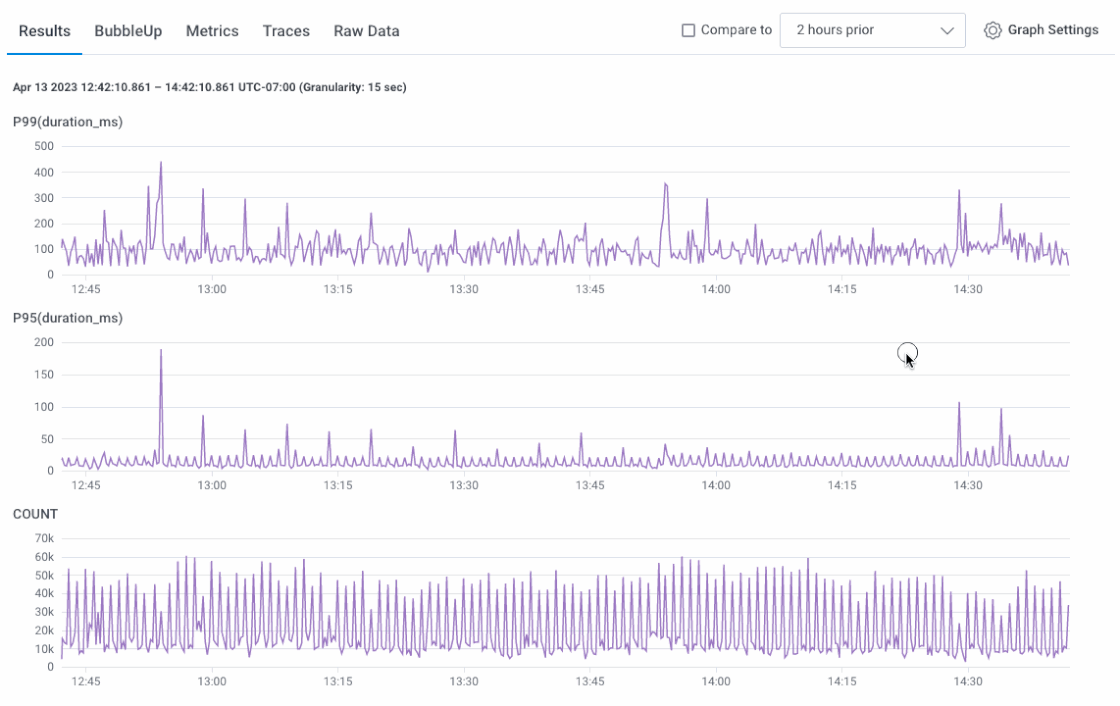Feature Focus: April 2023
By Nick Rycar | Last modified on May 3, 2023You know the old saying, I’m sure: “April deploys bring May joys.” Okay, maybe it doesn’t go exactly like that, but after reading what we’ve been up to for the past month, I think it might be time for an update. Let’s dive into our Feature Focus April 2023 edition.
Say hello to Query Assistant
The e-ink is barely dry on our Query Assistant announcement, but it’s worth repeating for good measure: Honeycomb has launched a natural language querying interface for Query Builder.
In other words, you can now ask questions in Honeycomb in plain English, and Query Assistant will translate that into our query syntax. This means that you don’t need to know how to structure a query before interrogating your data. It’s like a universal translator for what’s happening in your app. Where was this when I was learning SQL?!
Oh, and did I mention that Query Assistant is available to all users at no additional cost? Query Assistant is available to all users at no additional cost! Check it out today.
Dynamic gates for your GitHub Actions pipelines
Moving fast isn’t just about how quickly you can ship code to production. Pushing a change that negatively affects your users can bring development to a halt while assessing and untangling undesirable performance. What if your CI pipeline could proactively assess whether a deploy could degrade your users’ experience? Well, now it can. Honeycomb’s Deployment Protection Rules for GitHub Actions lets you block an in-flight deployment based on the results of a Honeycomb query. This functionality works similarly to triggers, wherein you can define your expected results and thresholds for a query, and anything that falls outside of those parameters gets blocked automatically.
O11y 101: The Honeycomb + OTel guide
Observability is transformative, but as is often the case when adopting new practices, it can be daunting to figure out where to start. Our latest guide, Getting Started with OpenTelemetry + Honeycomb, takes you through those initial steps. You’ll learn the benefits of instrumenting applications with OTel, how to send telemetry to Honeycomb, as well as the various ways you can visualize, query, and otherwise put your data to work.
Links and charts and sidebars, oh my!
We always work hard to make the look and feel of Honeycomb better every day—and this update is no exception. Here’s a selection of some handy UI/UX improvements from the past month.
Resizable trace waterfall sidebar
When investigating a trace, all of the metadata associated with each span is displayed in a sidebar to the right of the waterfall for easy reference. Some data, however, can be difficult to parse in this limited real estate, like a long URL or JSON hash. Now, you can drag and resize the sidebar as needed.

Trigger updates: autocomplete and direct links
Triggers are incredibly powerful—they let you define custom queries that alert you when they cross a user-defined threshold. We’ve made a couple of tweaks to make triggers easier to author and troubleshoot.
When creating a trigger, the query fields will autocomplete with relevant data from your telemetry, as with the query builder itself.

When viewing a trigger, there is now a clickable icon in the upper right that will run its associated query in Query Builder, giving you quick access to live state and trends for whatever behavior triggered an alert.

Environments as hyperlinks
Environments now work like other hyperlinks in Honeycomb. You can now open Environments in a new tab with CMD/CTRL + Click or via Right-Click + Open Link in New Tab.

Overlaying charts in query results
When querying multiple, related visualizations in Query Builder, it can be useful to display their output overlaid on the same graph rather than as side-by-side individual graphs. This makes it easier to compare and highlight differences, especially when different graph scales might not make the breadth of those differences immediately obvious.
In graph settings, you are now able to select Prefer Overlaid Charts, which will automatically overlay PERCENTILE, MAX, MIN, AVG visualizations and queries that do not include a GROUP BY field.

Wrapping up our Feature Focus April 2023 edition
That’s a wrap for April! You can find a full list of updates we’ve made to Honeycomb in our changelog, in Pollinators Slack, or by following our Twitter account via #changelog.
See you next month.
Related Posts
Introducing Honeycomb for Frontend Observability: Get the Data You Need for Actionable Customer Experience Improvements
Honeycomb for Frontend Observability gives frontend developers the ability to quickly identify opportunities for optimization within their web app. This starts with better OpenTelemetry instrumentation,...
Introducing Relational Fields
Expanded fields allow you to more easily find interesting traces and learn about the spans within them, saving time for debugging and enabling more curiosity...
Safer Client-Side Instrumentation with Honeycomb's Ingest-Only API Keys
We're delighted to introduce our new Ingest API Keys, a significant step toward enabling all Honeycomb customers to manage their observability complexity simply, efficiently, and...

